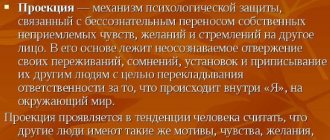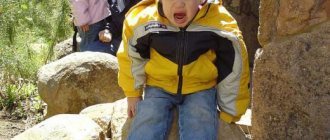In this article we will tell you:
- Methodology “House.Tree.Person”: characteristics
- Interpretation of a house drawing
- Relationship between drawing and sheet of paper
- Conclusion
Everyone knows the saying, part of which is to build a house, plant a tree and give birth to a son. It is no coincidence that the “Home. Tree. Man" (HCH) is one of the most popular among psychologists who use projective techniques in their work. In the article we will tell you what the projective technique “House.Tree.Person” is and how the drawing is correctly deciphered.
Characteristics of the psychological technique “House, tree, person”
Each person is a separate, specific personality that will not exist again. People differ in the very essence of the soul; their similarity is only external. The more someone becomes himself, the deeper and clearer his original features appear.
Valery Bryusov, Russian poet, novelist and playwright
A projective test for obtaining personality characteristics “House, tree, person” was proposed in the late 40s of the twentieth century by the American neuropsychologist J. Book. Initially, it was used to study the limits of an individual’s performance in production, as well as to determine the characteristics of his relationship with the team, which was the most important at that time. However, over time, Beech’s followers adapted this technique for children, and also somewhat simplified the diagnostic procedure. The objectives of the study are to assess:
- personal qualities of the subject;
- level of mental development;
- socialization among peers (especially important for children who enter kindergarten).
As for the age of the subjects, the test can be carried out for the first time with a child after he or she reaches 3–4 years of age, when the child has already formed elementary ideas about the rules for depicting objects.
Methodology E.S. Romanova and S.F. Potemkina
The test was developed by scientists to determine the individual psychological characteristics of a person, his ideas about himself, appearance, inner world, character.
When drawings are analyzed, image features are identified that serve as the basis for the following type of classification:
Aesthetic image. Such drawings are made by people with artistic abilities. The presence of light and flexible lines, expressive features, and conciseness of the image characterize the drawing. Schematic illustration. This is a diagram of the face and body, shown in profile and frontal view.
This type of image says about the author that he has an intellectual mindset; it is important for him to obtain general information; he is interested in details and details as needed. Scientists call this style synthetic cognitive with a tendency to generalize. Realistic image
It is carried out carefully, with all the details, drawing of the face, hair, ears, details of clothing. Such drawings reveal great pedants, prone to detail and an analytical cognitive style. Metaphorical image. A person depicts himself in the form of an object, animal, plant, literary character, etc. Such images are made by creative people, with great imagination and a sense of humor. Self-portrait in the interior. A person depicts himself surrounded by objects, against the backdrop of nature, in a room, in an office. Such drawings are made by people who have the ability to describe a plot; they consider the external subject environment important for themselves. Emotional self-portrait. When a person portrays himself in a certain emotional state. This self-portrait resembles a cartoon. It is done by emotional people who reflect on their own state. Moreover, the emotion can be portrayed as the opposite of what is being experienced. For example, an angry person often draws a smiling self-portrait. Depiction of pose or movement. A person depicts himself performing an action; with a high degree of probability he is passionate about sports and dancing. Self-portrait from the back. This is a characteristic of contradictory people or simply reflects the person's reluctance to participate in the experiment.
Correct administration of the projective drawing test
The child should not experience any physical or moral discomfort while working on the test.
Work can be carried out both in a group and individually. The only caveat is that if the technique is implemented in a team, then there should not be more than 4 people in the association. By the way, many psychologists defend their position that the most appropriate form of work is still individual, since in this case the experimenter has the opportunity to ask some leading questions.
For work, the subject receives a sheet of A4 paper and a hard-soft pencil, so that in the future they can evaluate the force of pressure on the sheet. The diagnostic algorithm is as follows:
- The experimenter, at his own discretion, determines which model of conduct is more productive. First: the child is given a sheet folded into an accordion shape three times (usually this is used with younger children). In this case, each object will be depicted on separate spreads. Second model: allow the subject to place all three illustrations on flat paper (in this case, several new and important aspects appear for interpretation - the distance of a particular object, pressure, and so on).
- Then the adult recommends: “Draw the house, tree and person the way you want.”
- While performing the task, the test organizer must record all comments, conditions and other external manifestations of the test taker. Such observation will be especially important for a psychologist in case the test subject exhibits deviations.
- After completing the drawing, an individual conversation is held. An adult can ask the child to explain who he drew, and also find out whether the character is in a good mood, what affects his well-being, and why the subject likes the depicted character the most.
The test time is limited only formally - 20–30 minutes. Usually children cope with the task faster.
For an objective analysis, the experimenter must carefully observe all the child’s manifestations during the drawing process.
Exercise
Content
1. Take a sheet of paper and draw a house, whatever you like. This is where the instructions end, because if you start setting conditions, this will force the subject into a certain framework and can significantly distort the final result and its interpretation.
2. Next, and only after the house has already been drawn, it is proposed to answer a number of questions:
- Where is this house located?
- How many rooms are there in the house?
- Who lives in it?
- Where is this house located?
- What is the most comfortable place in it, and why?
- Which place is the least comfortable, why?
Processing and deciphering the child’s results
Scoring and analysis
First of all, the experimenter must assess the symptom complexes of the subject’s personality. To do this, each of the 8 syndromes is assessed point by point from 0 to 3 points (0 - the element is not identified, 1 - the symptom is partially manifested, 2 - the symptom is half revealed, 3 - complete coincidence).
| Symptom complex | Feature of the drawing | Possible points |
| Insecurity |
| 0, 1, 2, 3 0, 1, 2, 3 0, 1, 2 0, 1, 2, 3 0, 1, 2, 3 0, 1 0, 1 0, 1 0, 1 |
| Anxiety (fear) |
| 0, 1, 2, 3 0, 1 0, 1, 2, 3 0, 1, 2, 3 0, 1 0, 1, 2 0, 2 0, 1, 2, 3 0, 2 0, 1 |
| Lack of self-confidence |
| 0, 2 0, 1 0, 1 0, 1 0, 1 0, 1 |
| Feelings of inferiority |
| 0, 1, 2, 3 0, 2 0, 1 0, 1 0, 1 0, 1 0, 1 0, 1 |
| Hostility |
| 0, 2 0, 1 0, 1 0, 1 0, 1 0, 1 0, 2 0, 2 0, 1 0, 2 |
| Conflict (frustration) |
| 0, 1, 2, 3 0, 1, 2, 3 0, 2 0, 2 0, 2 0, 2 0, 1 0, 1 0, 1 |
| Communication difficulties |
| 0, 2 0, 1 0, 2 0, 1 0, 1 0, 1 0, 1 0, 2 0, 2 0, 1 0, 1 0, 1 0, 1 |
| Depression |
| 0, 1, 2, 3 0,1 0,1 0, 2 0, 2 0, 2 |
Maximum possible points:
- Insecurity - 32.
- Anxiety - 33.
- Lack of self-confidence - 8.
- Feeling of completeness - 16.
- Hostility - 15.
- Conflict, frustration - 23.
- Communication difficulties - 18.
- Depression - 10.
If the result for each indicator exceeds 50% of the possible number of points, then this indicates that the child needs professional help from a psychologist and the selection of a correctional program. The norm is the sum of points scored from zero to a quarter of each maximum value.
Interpretation of drawing features
No detail in the process of analyzing a drawing can be superfluous. Here are the nuances you should pay attention to when examining the image and interpreting the child’s behavior:
| Criterion | Interpretation |
| Details |
|
| Erasing |
|
| Ground lines | A very important element of the drawing that determines determination.
|
| Outlines | This nuance provides information about the subject’s ability to maintain personal balance.
|
| Location |
|
| Perspective |
|
| Proportion | The ratio of details shows how strong the child’s tendency to avoid communication is, as well as the degree of his repression.
|
| Corrections and additions | If a child completes drawings of elements without erasing the previous ones, then he is prone to internal and external conflicts. |
| Uncertain drawing |
|
| Transparency | This characteristic indicates the child's desire to ignore reality. But some objects that are not filled with color do not lose touch with reality. That is why school psychologists do not pay attention to such a component (except in cases where transparency is inherent in about 70% of the illustration). |
Interpretation of key objects in the drawing
The sizes of the objects in the figure show the degree of relevance of the designated concept for the child.
House
- If the building is old, then the subject shows rejection of himself.
- If the house is located in the foreground, then the child is hospitable and loves to spend time with his peers.
- The steps leading to the door reveal the rational thinking of the “artist,” but if they rest against a blank wall, the subject has problems establishing communicative contact.
- The manner in which the walls are depicted indicates the ability to control the situation. So, too thick walls with a clear outline - the desire to be included in everything that happens in the real world. But thin, almost imperceptible contour lines betray the opposite: the desire to close off from reality.
- The pipe symbolizes warmth and comfort. By its absence, the subject shows a lack of heat. A drainpipe is a symbol of suspiciousness.
- Distorting details of the house reveals the subject's hostility. The same can be said about the absence or, conversely, an excessive number of doors, windows and rooms. A clear line demarcating the floors of the room indicates a rational approach to solving issues.
- The analysis of the images of doors deserves special attention. If they are not designated in the house, then it is difficult for the child to open up to other people, including loved ones. The presence of only side ones indicates the subject’s desire to escape from problems and give in. Pay attention to the order in which the element is depicted: the door, painted last, indicates a reluctance to communicate with people. An unlocked door is a symbol of openness. The larger the size of this object, the more comfortable the child feels in life. The castle indicates secrecy and hostility towards others.
- A well-drawn roof is a tribute to the desire to be protected. At an older age - a manifestation of infantilism. Too much canopy indicates that the subject is living in his fantasies.
- The presence of extensions may indicate resentment or anger towards the person who owns this house.
- A building in motion is an indicator of psychophysical disorders.
- The drawn interior of the living room shows the need for live communication.
- The absence of windows indicates alienation and hostility. In children's drawings you can often notice many openings. This speaks of a desire to explore the world by any means. Open shutters or curtains indicate anxiety in the subject. Wide open windows indicate the subject's straightforwardness. Introverted children often draw these elements with castles. It is also important to pay attention to the distribution of openings. If they are concentrated on the ground floor, then the child is very open; on the second - the fantasy world captures the subject more than the real one.
- If the path to the house is shown as short, then the subject prefers loneliness; a winding path reveals a creative person, but a straight path reveals an innovator who will always look for easy ways in everything. But if the path narrows towards the house, then the child is cheerful and sociable in public, but at home prefers to “recharge” in silence.
Tree
- Foliage. The round shape of the crown indicates excessive emotionality, but the round pattern of the leaves indicates that the child feels abandoned. If the leaves are marked schematically, then this is a sure sign that the subject wants to close people off. If a child draws palm leaves, then he dreams of traveling. Net-shaped leaves are a symbol of the ability to solve problems on your own.
- Lowered branches are a sign of reluctance to make efforts, but raised ones, on the contrary, show enthusiasm. In adolescence, it is also a thirst for power. Branches spread out in different directions indicate a search for ways of self-affirmation, but in children this arrangement indicates confusion.
- A well-drawn crown shows the exaltation and emotionality of the subject.
- Trunk. If it is drawn with one line, then the subject does not want to look at the world objectively, preferring to live in an illusory world. The curve is an indicator of inhibition. A tree torn out of the soil indicates a child’s lack of contact with the outside world. When the trunk expands downwards, this indicates that the child is looking for sympathy and support from loved ones.
- If the illustration shows not one, but two trees, then perhaps the person being tested in this way showed himself and an adult who is significant to him (this requires clarification in the conversation).
- The depiction of the earth with one stroke shows the desire for order, and with several strokes it shows the desire to obey only one’s own rules. The latter option is most often seen in illustrations made by children, which deserve the definition of “obedient.”
- Small roots symbolize curiosity, which is the driving force behind almost all of the subject's actions. Two lines as roots are a desire to suppress some manifestations in oneself (not always bad).
- The symmetry of the plant shows the subject’s desire to be in harmony with the world around him. This is also a manifestation of the fact that the child is undecided about a choice.
Did your child draw several trees? He may simply not be following the test instructions, or may have signs of mental retardation. However, this does not apply to the situation when 2 trees appear in the picture.
Human
Children usually spend the most time depicting a person. It is important for the experimenter not to interrupt or distract the subject during this process.
- Head. With a large head, the subject shows his understanding of the concept of “smart person”, and also clearly places himself in this category. Small heads, as a symbol of intellectual underdevelopment, are drawn by children aged 9–16 years, especially those with learning problems. Also, a tiny part of the body indicates the child’s shyness.
- Neck. Long - the desire to control everything that happens around. Usually this element is inherent in the drawings of very active children. Thick and short indicates compliance.
- Shoulders. Wide - recognition of the power of force over the mind. Small ones are a symbol of a feeling of one’s own worthlessness, belittling one’s merits. Sloping shoulder girdle - a feeling of guilt before a loved one.
- Torso. A large one speaks of dissatisfaction with something, and a small one speaks of one’s own low value.
- A prominent chin shows the subject's need to dominate. Wide is usually drawn by indecisive guys.
- Sparse or too thin eyebrows are usually depicted by children who approach reality with a great deal of skepticism.
- Those who have a hard time withstanding criticism tend to have big ears. Disproportionally small - a symbol of the desire to drown out any attempts to influence the choice or decision of a teenager. For children this does not have any symbolic meaning.
- Small eyes show the child's isolation. Lush eyelashes are often painted by children aged 10–16, as at this age the desire to show off oneself awakens.
- A wide smile denotes insincerity, forced friendliness. The dash mouth demonstrates passive acceptance of life; in children this may be due to the overprotectiveness of adults. Clearly drawn teeth are present in pictures of children who often show aggression.
- The larger the nose, the more cheerful the subject's disposition. The emphasis on the nostrils is made by children who are prone to demonstrating anger.
- Hair and eyebrows: the more shaded these elements are, the stronger the expression of anxiety in the subject. Unpainted hair, decorated only with an outline, speaks of the child’s hostility.
- The longer the arms, the more ambitious the child is tested. Limbs behind the back are drawn by those who do not know how to compromise. Hands are drawn on the chest by suspicious children. The limbs are pressed too tightly to the body by clumsy guys who constantly hear such a reproach addressed to them. Excessively large hands are depicted by impulsive subjects. If a child completely “forgot” about his limbs, then perhaps he has some psycho-emotional disorders. Hands behind your back is a desire to hide something. The absence of palms may be a sign that the subject does not feel maternal love. The more fingers a child draws, the more ambition he has. Thin phalanges are a symbol of hostility. Primitive knuckles symbolize callousness, sometimes even aggression. If there are fewer than five fingers, then the subject may be dependent on the opinions of adults and often feels powerless in resolving certain issues.
- If a child begins to depict a person by drawing legs, then the “artist” treats others with a degree of timidity. The unequal size of these limbs indicates a desire for independence. The emphasis on the legs is usually made by subjects who tend to be rude. The absence of such body parts indicates shyness and isolation. Dependence on authoritative adults is shown by disproportionately small feet. On the contrary, too long ones indicate a desire to demonstrate one’s independence.
- If the back of the figure’s head is visible, then the child tends to be withdrawn. A running man symbolizes the desire to hide something. A figure shown only in outline speaks of a reluctance to have anything in common with others. This situation can arise if a child (most often a teenager) has problems both with studying and with establishing contacts with peers.
- A body unbalanced in space indicates tension. The image of a doll is a recognition of one’s compliance. If a child draws, for example, Baba Yaga, then he clearly has a hostile attitude towards women. But a clown in adolescence is a symbol of self-contempt.
The “House, Tree, Person” method is a useful test for a psychologist working with children. However, the experimenter should be very careful in interpreting the test results, also including notes taken during the conversation with the child, as well as referring to his own experience. Only in this case can the analysis be considered objective.
Relationship between drawing and sheet of paper
| Characteristic | Interpretation |
| Occupies a small area | Feelings of inferiority. A person wants to escape real life |
| Takes up the entire page | Severe frustration caused by limiting environmental influences, hostility, irritability |
| Fence around the house | The desire for isolation, protection from the outside world |
| In the center | Insecurity, inability to adapt to the environment |
| Left | Nostalgic mood, emphasis on experiences that happened in the past, focus only on the experience of the past |
| On right | The desire to bring the future closer, dissatisfaction with the current situation, a thirst for change for the better |
| At the bottom | Lack of self-confidence, indecision, lack of interest in increasing one’s importance |
| Up | Quite high self-esteem, dissatisfaction with one’s position in society, a feeling of lack of recognition from others |
WINDOW
Enlarge
Large windows are evidence of a child’s openness and communication skills. Does the house have many windows? The child wants more communication with his peers. Are the windows curtained? The child experiences communication difficulties. Windows with bars are a sign of a child with complexes. This child needs help. If a child depicts windows only on the upper floors, right under the roof, and the first floors remain empty without a “peep into the world,” this indicates a certain gap between reality and the world of fantasies and miracles.
Example
I can't draw. From the word absolutely. No spatial imagination.
As part of the marathon, I drew this picture. And although I have always lived in apartment buildings, I associate the concept of “house” with such a small hut, with an attic or second floor and a balcony. And here are the answers to the questions:
1. The house is located near a forest (coniferous), on the outskirts of the village. 2. The house is small on the outside, but inside it is very spacious and cozy, it has many rooms, you can even get lost. Each guest can find a secluded corner. 3. An old grandmother lives in it, kind, wise and cozy. And when you need to rest or think, you come to her. Or just hiding from the bustle of the world. 4. It stands on the outskirts of a village somewhere in Central Russia, and behind the fence there is a forest, necessarily coniferous. 5. He has a balcony on the second floor. It is good to sit on it and admire the forest. 6. There is also a cluttered closet where temporarily unnecessary things are stored. It's cramped and uncomfortable there.
Read also:
Where does sexual satisfaction begin? Fundamental differences between female orgasm and male orgasm. Methods for getting out of depression. Phobias in our lives. Neurogenic copulative dysfunctions in men. Sexual incompatibility. How to maintain sexual harmony in a relationship How to prevent mental health problems in children Dissocial personality disorder - sociopathy A child stutters - what should parents do? Popular articles Troubles in the family: from the practice of Western specialists Psychological test for children “HOME” Are dialogues necessary in bed?
PIPE
Enlarge
Thick smoke rushes upward from the chimney - this means that the child inside is tense. A thin stream of smoke indicates a lack of communication between the child and his parents. The pipe is hidden and is located entirely on the side of the roof that is not visible in the picture - the child is clearly alienated from emotional connections with others, even with his own family.
If your child needs psychological correction, our child psychologists will be glad to see you and use their wealth of experience to make the child’s life and yours happier and more harmonious. Make an appointment:
- Call (Monday to Saturday from 9:30 to 22 hours)
- Write by email (24/7)
- Write to us through the VKontakte group: https://vk.com/sdk_pazl











